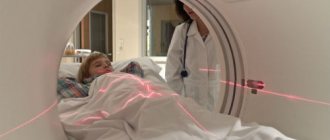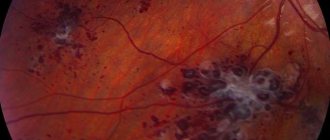Myasthenia gravis is an autoimmune disease that causes muscle weakness. The disease develops due to a disruption in impulse transmission between neurons and muscle fibers. The pathological process develops simultaneously with thymic hyperplasia. More often, the disease is diagnosed in women after twenty years of age, but in some cases it occurs in children, young people and the elderly.
Neurologists at the Yusupov Hospital diagnose myasthenia gravis using modern instrumental diagnostic methods. The latest medications and non-drug therapy methods are used for treatment. Specialists at the physical rehabilitation clinic individually create a set of gymnastic exercises that help increase muscle strength.
Causes
Scientists identify two main causes of myasthenia gravis: congenital gene pathology and exposure to provoking factors.
The congenital form of the disease is associated with a mutation in the patient’s genome, as a result of which the transmission of information through synapses (special adapters that deliver impulses to their destination) stops. The acquired form of the disease occurs under the influence of the following provoking factors:
- Benign or malignant neoplasms;
- Autoimmune diseases (dermatomyositis, scleroderma);
- Inadequate physical activity;
- Constant stress;
- Viral diseases.
The mechanism of development of the disease is as follows: in the human body, the synthesis of special proteins begins, which destroy similar structures. This causes disruptions in the transmission of neuromuscular impulses. Myasthenic crisis develops under the influence of the following factors:
- Injuries;
- Stress;
- Acute infections;
- Some medications.
During pregnancy, symptoms of the disease in women may worsen or disappear.
Expert opinion
Author: Olga Vladimirovna Boyko
Neurologist, Doctor of Medical Sciences
According to the latest data, myasthenia gravis accounts for 0.5-5% of cases per 100 thousand population. Myasthenia gravis affects women 2-3 times more often. In most cases, the disease debuts before the age of 40. Patients with myasthenia gravis become disabled group 1 or 2 in 30% of cases. In Russia, the disease accounts for 2.5% of cases. The exact causes of myasthenia gravis are still unknown. Doctors identify predisposing factors, the presence of which increases the risk of developing the disease.
Diagnosis of myasthenia gravis can be delayed due to the variety of clinical manifestations. The Yusupov Hospital uses the latest equipment to examine patients: CT, MRI, EEG. To clarify the diagnosis, a serological blood test is performed in a modern laboratory. Thanks to an integrated approach, experienced doctors identify myasthenia gravis at any stage of development. An individual treatment plan is developed for each patient. This approach allows you to achieve positive results in a minimum amount of time.
Also at the Yusupov Hospital, relief of myasthenic crisis is available in intensive care and intensive care settings. The drugs used meet safety and quality standards.
Prevention
This is a serious diagnosis, but with timely treatment, the patient has a great chance of living a full life. It will be necessary to avoid the following provoking factors:
- intense physical activity, which can accelerate the disease and lead to its exacerbation;
- prolonged exposure to the sun, especially under the influence of direct ultraviolet radiation;
- saunas, steam baths, solariums - they lead to overheating of the body, which entails consequences;
- prolonged stress and emotional overstrain;
- constant overwork of the body from prolonged monotonous work at the computer or book;
- taking certain medications.
When visiting your doctor, you should be sure to familiarize yourself with all the medications that are strictly prohibited for people with autoimmune disorders. They can trigger myasthenic crisis and even lead to death.
Signs of the disease in adults
Clinical signs of myasthenia gravis may occur sporadically. The rest of the time the patient is in a state of remission (symptoms of the disease are not expressed). This is typical for the ocular form of myasthenia gravis.
You should make an appointment with a neurologist at the Yusupov Hospital if you have the following neurological symptoms:
- Rapid fatigue when chewing food, walking, working at the computer or reading;
- Violation of facial expressions, speech, voice;
- Motor function disorders.
At the onset of the disease, the clinical picture is so unexpressed that a person does not pay special attention to the existing abnormalities. Due to constant employment and heavy workload at home and at work, patients consult a doctor when the manifestations of the disease become noticeable.
Neurologists distinguish 3 groups of symptoms of myasthenia gravis in adults:
- Ophthalmic;
- Muscular;
- Respiratory.
Ocular manifestations of the disease include ptosis (drooping of the eyelid), diplopia (double vision), deviation to the side of the eyeballs when they move. As the load increases, the nervous symptoms worsen, the patient feels a headache and soreness in the eyes.
Muscular signs of myasthenia gravis are manifested by weakness in various muscle groups:
- Hypomimia – weakness of the facial muscles, when the patient has problems puffing out his cheeks, smiling, or closing his eyes;
- Bulbar syndrome - a swallowing disorder, which leads to the patient coughing while eating, choking, nasal during a conversation, and his speech becomes incomprehensible;
- Chewing weakness - the patient has difficulty chewing food, he gets tired quickly, and the disturbance in the eating process is aggravated by drooping of the lower jaw;
- Weakness in the neck and torso - it becomes increasingly difficult for the patient to hold his head, which tilts back or hangs down;
- Weakness in the limbs - due to the fact that the extensor muscles are predominantly affected, the patient experiences powerlessness after heavy exertion.
- Respiratory disorders are manifested by weakening of the muscles of the diaphragm, laryngeal and intercostal muscles. In this case, it becomes necessary to connect the patient to a ventilator. Patients are hospitalized in the intensive care unit around the clock, regardless of the day of the week.
Read also
Neuralgia
Neuralgia is a disease that is a lesion of the peripheral nerve.
It manifests itself as a strong, burning, acute pain that is felt in the area of innervation of the affected (along) nerve. Types… Read more
Senestopathies
Senestopathies are various painful sensations that are almost always difficult to describe by patients, originating from various areas of the body, internal organs, and which cannot be explained...
More details
Aphasia
Aphasias are speech defects that appear with minor brain damage, most often affecting the left hemisphere in right-handed people, and consisting of various forms of speech changes. Location and size...
More details
Atherosclerosis
Atherosclerosis is a vascular disease that is caused by a decrease in the elasticity of the vascular wall, the deposition of cholesterol on the inner surface and, as a result, the appearance of atherosclerotic plaques. Atherosclerosis…
More details
Facial paralysis (Bell's palsy/facial neuritis)
Facial paralysis is spontaneous weakness of ½ of the face. The cause is swelling of the facial nerve, as a result of its compression inside the temporal bone or in the outlet from it. Most often this leads to...
More details
Forms of the disease
Neurologists distinguish the following forms of myasthenia in adults:
- eye;
- bulbar;
- Generalized;
- Myasthenic syndrome.
The ocular form of myasthenia is manifested by damage to the muscle fibers responsible for the movements of the eyeball, raising and holding the upper eyelid. These functions are disrupted with increasing physical activity, a stressful situation, and after taking anticholinesterase drugs.
The bulbar form of myasthenia is characterized by disturbances in the process of chewing food, swallowing, and speech. The patient's voice becomes hoarse and nasal. Since facial expressions are minimally expressed, it seems that the person looks much younger than his age. His smile resembles a grin.
In the generalized form of myasthenia, all muscles are affected. They are gradually involved in the pathological process. First, the movements of the eyeballs are impaired, then the function of the facial and neck muscles. After some time, the muscles of the musculoskeletal system are involved in the pathological process.
Myasthenic crisis can develop regardless of the form of the disease and the severity of movement disorders. The patient suddenly experiences double vision, severe weakness and impaired activity of the larynx. It becomes difficult for him to speak, breathe, and swallow. The pulse quickens. Salivation increases. In severe cases, the pupils dilate, the heartbeat quickens, and paralysis occurs with preservation of sensitivity.
A rare type of myasthenia gravis is Lambert-Eaton syndrome. The disease is characterized by disruption of neuromuscular transmission. This leads to fatigue, myalgia (muscle pain), paralysis of the extraocular muscle, and autonomic disorders. This syndrome develops in patients with small cell lung cancer and other malignant tumors. Patients often have difficulty rising from a sitting or lying position.
Myasthenia Gravis, or pseudoparalytic myasthenia, develops against the background of dysfunction of the endocrine system and autoimmune diseases - lupus, rheumatoid arthritis. It comes in the following types: congenital, newborn, juvenile, generalized adult myasthenia.
Make an appointment
Kinds
Scientists offer a large number of classifications of this type of pathology; for convenience, it is most appropriate to use a simplified version.
The ocular form of the disease has several varieties. According to the etiological criterion, they are distinguished:
- genetically determined (congenital) pathology, which is transmitted along the hereditary line and is associated with gene mutations;
- acquired form, in which pathology develops at a late age under the influence of unfavorable factors.
Depending on the severity there are:
- light;
- average;
- heavy.
According to the nature of the flow:
- myasthenic;
- stationary;
- progressive;
- malignant.
In addition, there is myasthenia gravis:
- Generalized (with or without breathing problems);
- Local, it includes the following varieties:
- pharyngofacial;
- ophthalmic;
- musculoskeletal.
Among people over 20 years of age, symptoms of the disease are more often found in women than in men, and after 40 years of age the ratio of cases is 1:1.
Infantile myasthenia gravis
Symptoms of myasthenia gravis in children differ from those in adults. Congenital myasthenia is determined already at the stage of intrauterine development of the fetus: it is almost or completely inactive. After birth, due to the fact that the child cannot breathe, he dies. Neonatal myasthenia is manifested by the following symptoms:
- Lethargy;
- Difficulty breathing;
- A weak cry;
- Fatigue quickly.
- The baby quickly sucks milk. His mouth is constantly slightly open, his eyes are fixed, and swallowing is difficult.
Early childhood myasthenia is diagnosed in children under two years of age. Symptoms of the disease are similar to those of myasthenia gravis in adults:
- drooping eyelid;
- Gaze paralysis;
- Strabismus.
When the respiratory muscles are involved in the pathological process, the child becomes passive. If the masticatory muscles are affected, he may refuse to eat completely.
Childhood and youth myasthenia gravis affects children aged two to ten years. The disease is more often detected in girls. The symptoms are similar to the early childhood type of the disease. The difference lies in diagnosis: it is easier to ask an older child about symptoms, which allows for therapy to be started sooner.
Forecast
This type of disease has the most favorable prognosis if all medical recommendations have been accepted and followed. Other types of pathology contribute to disability when a person loses:
- initial professional skills;
- ability to communicate normally;
- the opportunity to eat normally;
- ability to take care of oneself;
- motor activity.
When the first symptomatic deviations from the norm appear, it is very important to contact medical centers, hospitals, and undergo a quality consultation.
Diagnostic methods
To establish an accurate diagnosis and find out the causes of nerve function disorders, neurologists at the Yusupov Hospital conduct a comprehensive examination of the patient. It includes:
- Patient interview;
- General and neurological examination;
- Palpation, percussion and auscultation;
- Neurological examination.
Doctors at the Neurology Clinic prescribe the following laboratory and instrumental studies:
- Clinical and biochemical blood test;
- Electromyography, which is used to assess muscle condition;
- Genetic screening to determine the presence of a mutation gene in a DNA chain;
- Electroneurography, which is used to check the speed of impulse transmission;
- Magnetic resonance imaging, which provides data on the presence of thymic hyperplasia and tumor-like neoplasms.
A fatigue rate test is also performed. The doctor asks the patient to quickly perform chewing movements with his jaw, swing his limbs, clench and unclench his hands, and quickly squat. When performing a protein test, a special substance is injected under the patient's skin. Within half an hour a person feels a significant physical lift. His fatigue goes away. This condition does not last long. After the drug takes effect, the symptoms of myasthenia gravis return.
The decrement test is a method for studying the process of transmission of neuromuscular impulses. It aims to study five muscle groups. Each of them is exposed to an artificial provocateur, causing rhythmic contraction of muscle fibers. For any form of myasthenia gravis, the response rate will be low.
To conduct a serological test, the patient donates blood 4 hours before eating to obtain serum. Laboratory assistants perform enzyme immunoassay. Using this test, antibodies to the acetylcholine receptor are detected in 90% of patients with myasthenia gravis.
The pharmacological diagnostic criteria include the proserine test. Doctors use proserin or kalimine forte to carry it out. In 15% of patients with myasthenia gravis, movement disorders are fully compensated during the procedure.
Make an appointment
general information
Any muscle contracts under the influence of a nerve impulse. It is transmitted from the nerve to the muscle fiber through a special connection called a synapse. During the passage of the impulse, a large amount of acetylcholine is released, which serves as a mediator of the process. An increase in its concentration leads to stimulation of muscle receptors and provoke fiber contraction.
With myasthenia gravis, the body begins to actively produce antibodies to receptors that respond to increased concentrations of acetylcholine. As a result, they are gradually destroyed, and the quality of the muscle's response to stimulation is constantly deteriorating. The more intensely the muscles work, the more noticeably the quality of the synapse decreases. As the pathological process progresses, destruction captures an increasing number of receptors, which can lead to a complete loss of the ability to contract, i.e. paralysis
Complex therapy
Neurologists at the Yusupov Hospital treat myasthenia gravis with the latest medications that are effective and have a minimal range of side effects. All medicines are registered in the Russian Federation. Thanks to the cooperation of doctors at the Yusupov Hospital with research institutes, patients at the neurology clinic have a unique opportunity to receive the latest drugs that are undergoing the last stage of clinical research.
Neurologists use the following pharmacological drugs to treat myasthenia gravis:
- Anticholinesterase drugs;
- Corticosteroid hormones;
- Cytostatics;
- Potassium salts.
In most cases, doctors at the Neurology Clinic choose a three-step treatment strategy for myasthenia gravis. It includes compensation of neuromuscular transmission, correction of autoimmune disorders, and effects on the thymus gland. Compensation for neuromuscular transmission is carried out with potassium preparations. They enhance the synthesis of acetylcholine. Medicines of this pharmacological group can be used at all stages of therapy. During long periods of remission, they are prescribed to prevent exacerbation.
Neurologists carry out pulse therapy with glucocorticoids when previous medications are ineffective, in preparation for surgery and to combat bulbar complications. The doctor calculates the dosage individually for each patient.
Cytostatics are used to influence the thymus gland. In case of crises or respiratory failure in the Yusupov Hospital, patients with myasthenia gravis undergo plasmapherosis sessions. One of the new therapy methods is cryopherosis. Using low temperatures allows you to cleanse the blood and get rid of harmful substances.
Also used to treat myasthenia gravis are immunosorption (extraction of antibodies from the blood), gamma irradiation of the thymus (exposure to the thymus gland by radioactive radiation), and physiotherapeutic procedures:
- Electrical muscle stimulation;
- Inhalations;
- Massage;
- Electrophoresis.
If conservative therapy is ineffective, surgeons perform a thymectomy - removal of the thymus gland. There are three main methods of performing this surgical intervention:
- Transternal – the thymus gland is removed through an incision in the sternum;
- Transcervical - removal of the thymus is performed through an incision at the base of the neck;
- Robotic surgery – surgery is performed using robotic manipulators.
75% of patients experience a significant improvement in their health after surgery.
Advantages of the clinic
“Health Energy” is a modern multidisciplinary medical center, equipped in accordance with the most stringent standards. We do everything to ensure that every patient receives the most complete and effective medical care, regardless of diagnosis. At your service:
- diagnostics using expert class equipment;
- modern laboratory to obtain accurate and fast results;
- comprehensive programs designed to assess the health status of patients of different gender, age and profession;
- selection of treatment on an individual basis, taking into account all indications and contraindications;
- an integrated approach to therapy, which uses not only medications, but also physiotherapy, exercise therapy, massage, etc.;
- organizing remote consultations with doctors from the best clinics in the world;
- assistance in organizing sanatorium-resort treatment from selecting a specific sanatorium to completing documentation;
- comfortable day rooms;
- organization of hospitalization in specialized hospitals, if there are indications for this;
- comprehensive rehabilitation programs for patients with various diseases;
- detailed recommendations on disease prevention and lifestyle.
More recently, the diagnosis of myasthenia gravis sounded like a death sentence. The person was by default doomed to death from gradual paralysis of the respiratory muscles. Modern treatment methods, although they do not make it possible to completely get rid of the pathology, can achieve stable remission for many years. If you yourself or a loved one begin to notice causeless muscle weakness, especially noticeable in the evening hours, do not delay in contacting a neurologist. The doctors of the Health Energy clinic are waiting for you!
Diet therapy and lifestyle correction
For patients with myasthenia gravis, neurologists prescribe special diet therapy. Its goal is to increase the protective function of the body. Dishes should contain large amounts of potassium, phosphorus, calcium and vitamins.
Fatty and fried foods, smoked foods, and canned foods are excluded from the menu. Patients are advised to stop drinking alcohol. Patients should also follow the following doctor's recommendations:
- To refuse from bad habits;
- Control body weight;
- Reduce time spent in direct sunlight;
- Avoid physical and emotional overload;
- Alternate work with rest.
Without consulting a doctor, patients with myasthenia gravis should not take the following medications: diuretics, fluoroquinols, tranquilizers, antipsychotics, drugs containing fluoride, magnesium, quinine.
Diet
An important aspect of preventing myasthenia gravis is diet. The daily diet should be balanced in basic nutrients (proteins, fats, carbohydrates) and have sufficient, but not excessive calories. If a person is overweight, it is recommended to maintain a calorie deficit (no more than 10-15% of the daily value). The menu should contain foods high in potassium (potatoes, bananas, etc.). If prescribed by a doctor, you can take multivitamin medications.










